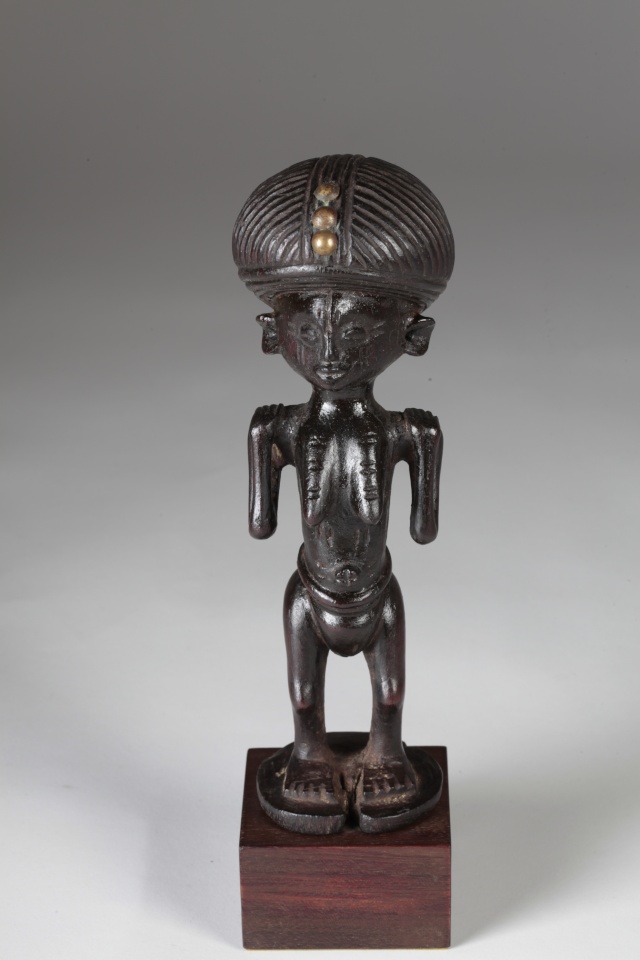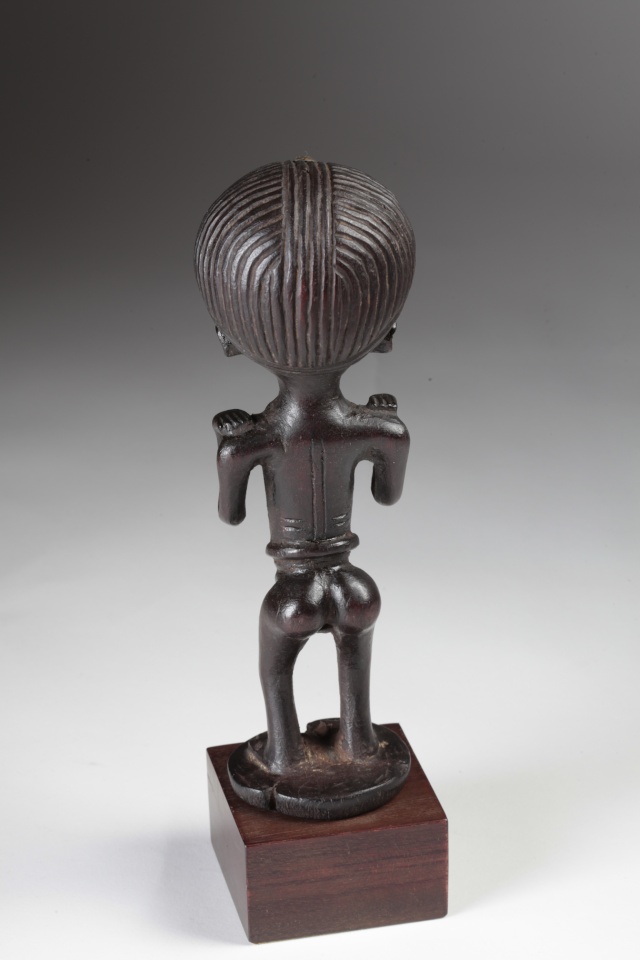Chokwe people, Female Statue, Shinji Figure, Uruunda Region (Lower Congo/Angola)
Pagina 1 di 1
 Chokwe people, Female Statue, Shinji Figure, Uruunda Region (Lower Congo/Angola)
Chokwe people, Female Statue, Shinji Figure, Uruunda Region (Lower Congo/Angola)

Chokwe people, Female Statue, Shinji Figure, Uruunda Region (Lower Congo/Angola)
19th century
Wood with black and oozing patina, metal
H.9,4 in/ 22.5 cm
Private collection, Milan
Photo by Luca del Pia
Arti delle Mani Nere All Rights Reserved
Provenance
- Spanish private collection
- Galeria Raquel Y Guilhem Montagut, Barcelona
Exhibition
Bruneaf, 9-13 June 2010

Second the Scholar Manuel Jordan, this is a Chokwe female figure, possible Shinji. Chokwe with oozing oil surface are rare.
The particular gesture featured by the figure, with arms bent straight up and (inverted) hands “grabbing” the shoulders and the specific “belt” it shows above the waist, indicate that the figure’s “dialogue” is directly related to female initiation (mwali). When female graduates (miali; singular mwali, also name of initiation) come out of the period of seclusion and their private enclosures they are fully covered with oil so their skin is shinny, just like what it see on the figure’s surface. So, within this context it would make sense the figure is “oiled” to mirror female initiation steps and practices. This is actually quite rare but is documented the use of carved wooden figures by women in that context.
About the gesture, it is one of three arm positions in a mwali graduation dance: initially the arms are extended out to the front, then the arms are brought towards the body and crossed to create an “X” covering the chest, and last (3d step) the arms are “opened up” to take the precise position that the figure shows with hands on the shoulders. It can also see that during dance “imitated” in Pwo (female mask character) performances among the Chokwe and other groups.
Relating the belt, it represent a waist band that women wear when they get married and have sex (for the first time at least) with their husbands. This waistband is normally covered in beadwork and is considered to be highly attractive and to make the woman “irresistible” to the man. The scarification marks support all this as they reflect a mature and fertile woman.

It possible speculate that the piece was owned by somebody of high rank, possibly an officer of female initiation ceremonies for a chief’s court: in which case the figure itself would also serve for education during the initiation process as a form of model and perhaps commemorating the “spirit” of the founder of a particular lineage.
The didactic purpose is only one of many possible uses of this figure, which does not preclude the "magico-religious" purpose, "embodies" an ancestor: it is therefore coherent use during divination and the presence, in the piece, of one or more cavities to contain the "medicine" (vitumbo). The figure have anal cavity is also consistent as a place for a "charge" and indeed it is an important place for mwali as the initiates are applied enemas for cleansing as well. This is all a symbolic universe where all things correlate.
Indeed the figure could have been used in divination. Although the figurative sculpture belongs to the kingdom of men, there are also female diviners that use figures of this type. The set of the details of the figure make it more "exciting" and attractive the piece, a strategy used by diviners to attract all the force (good or bad) in the "trap" constituted by the spirit of the ancestor, so that we can mediate.
The presence, in piece, of many elements related to the female initiation rites, make it unlikely the use of this object by a man diviner. However, it is common to find male and female diviner operating on the same individual or in relation to specific issues. Finally, most probably, the statue has been used by a female diviner who officiated in initiation rituals.
Bibliography
- Bastin, Marie Louise. "Art decoratif tshokwe" 2 vols. Lisbon: Companhia de Diamantes de Angola, Servicos Culturais, 1961
– Bastin, Marie Louise. “Les styles de la sculpture tshokwe”. Arts d’Afrique Noir 19 (autumn 1976): 16-35
- Bastin, Marie Louise. "La sculpture tschokwe". Meudon, France: A. and F. Chaffin, 1982
- Jordán, Manuel, "Chokwe! Art and Initiation among Chokwe and Related Peoples" (exh. Cat. Birmingham Museum of Art, Alabama). New York: Prestel, 1998.

Chokwe people, Female Statue, Shinji Figure, Uruunda Region (Lower Congo/Angola)
19mo secolo
Legno con patina scura ed esudante, metallo
H. 22.5 cm
Collezione privata, Milano
Photo by Luca del Pia
Arti delle Mani Nere All Rights Reserved
Provenienza
- Collezione privata spagnola
- Galeria Raquel Y Guilhem Montagut, Barcelona
Esposizioni
Bruneaf, 9-13 June 2010
Secondo lo studioso Manuel Jordan, si tratta di una figura femminile Chokwe, possibile Shinji. Le figure Chokwe con patina sudante olio sono molto rare.
Il particolare gesto che caratterizza la figura, con le braccia piegate verso l'alto e le mani invertite ad "afferrare" le spalle, e la tipica "cintura" visibile sopra la vita, indicano che questa figura di "dialogo" è direttamente correlata all’iniziazione femminile (Mwali). Quando le donne ormai iniziate (Miali; singolare Mwali, che è anche il nome dell’iniziazione) escono dal periodo di isolamento e dalle capanne ove erano segregate vengono completamente coperte di olio così che la loro pelle sia brillante, proprio come quello che si vede sulla superficie della figura. Quindi, in questo contesto, ha senso che la figura presenti una patina sudante olio, rispecchiando i diversi steps dell’iniziazione femminile. Questa pratica è abbastanza rara ma è stato documentato l'uso, da parte delle donne, di figure in legno intagliato, in questo contesto.
In merito al gesto, è una delle tre posizioni che le braccia assumono durante la danza d’iniziazione Mwali: inizialmente le braccia sono estese verso la parte anteriore, poi le braccia sono portate verso il corpo e incrociate per creare una "X" che copre il petto, e nell'ultimo ( terzo passaggio) le braccia sono "aperte" per prendere la precisa posizione che la figura mostra con le mani sulle spalle. Ciò è rintracciabile anche durante la danza della Pwo (maschera femminile) tra i Chokwe e di altri gruppi affini.
La cintura rappresenta invece una fascia in vita che le donne indossano quando si sposano e fanno sesso (almeno per la prima volta) con i loro mariti. Questa cintura è normalmente coperta di perline ed è considerata molto attraente tanto da rendere la donna "irresistibile" per l'uomo. I segni di scarificazione supportano tutto questo in quanto rispecchiano una donna matura e feconda.
E' possibile ipotizzare che il pezzo fosse di proprietà di una persona di rango elevato, forse un ufficiale per le cerimonie di iniziazione femminile alla corte di un capo: in questo caso la figura stessa servirebbe anche per l'istruzione durante il processo di iniziazione come una forma di modello e, forse, per commemorare la "spirito" del fondatore di una particolare stirpe.
L'obiettivo didattico è solo uno dei molti possibili utilizzi di questa figura, che non preclude anche lo scopo magico-religioso, "incarnando” un antenato: è quindi coerente l’utilizzo durante la divinazione e la presenza di una o più cavità per contenere le “medicine” (vitumbo). La cavità anale è quindi un luogo di "carico": gli iniziati effettuano dei clisteri per essere puliti prima dei riti Mwali. E’ tutto un universo simbolico dove tutte le cose sono correlate.
La statua potrebbe quindi essere stata usata nella divinazione. Anche se in generale la scultura figurativa appartiene al regno degli uomini, vi sono anche indovini femminili che utilizzano figure di questo tipo. L’insieme dei dettagli della figura renderebbero più "eccitante" ed attraente il pezzo, una strategia questa utilizzata dagli indovini per attirare tutte le forza (buone o cattive) nella "trappola" costituita dallo spirito dell’antenato, in modo da poterci mediare.
La presenza, nel pezzo, di molti elementi legati ai riti di iniziazione femminili, rendono improbabile un uso di questo oggetto da parte di un diviner uomo. Tuttavia è comune trovare diviner maschi e femmine che operano sullo stesso individuo o relativamente a specifiche problematiche. Per concludere, con molta probabilità, la statua è stata impiegata da una diviner femmina che ha officiato nei rituali di iniziazione.
Bibliografia
- Bastin, Marie Louise. "Art decoratif tshokwe". 2 vols. Lisbon: Companhia de Diamantes de Angola, Servicos Culturais, 1961
– Bastin, Marie Louise. “Les styles de la sculpture tshokwe”. Arts d’Afrique Noir 19 (autumn 1976): 16-35
- Bastin, Marie Louise. "La sculpture tschokwe". Meudon, France: A. and F. Chaffin, 1982
- Jordán, Manuel, "Chokwe! Art and Initiation among Chokwe and Related Peoples" (exh. Cat. BirminghamMuseum of Art, Alabama). New York: Prestel, 1998.

 Argomenti simili
Argomenti simili» Chokwe people, Female Statue, Shinji Figure, Uruunda Region (Lower Congo/Angola)
» Vili people, Nkisi Figure, Lower Congo Region
» Kongo people, Ritual Whistle, Lower Congo Region
» Songye people, N'kisi figure, Region of Eki or Beneki, Congo
» Lega people, Mokolo (Mukulu) figure, Shabunda Région, Kivu, Congo
» Vili people, Nkisi Figure, Lower Congo Region
» Kongo people, Ritual Whistle, Lower Congo Region
» Songye people, N'kisi figure, Region of Eki or Beneki, Congo
» Lega people, Mokolo (Mukulu) figure, Shabunda Région, Kivu, Congo
Pagina 1 di 1
Permessi in questa sezione del forum:
Non puoi rispondere agli argomenti in questo forum.|
|
|

 Indice
Indice